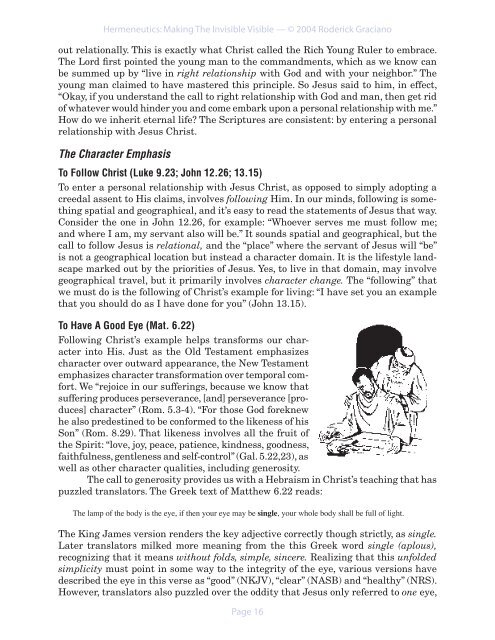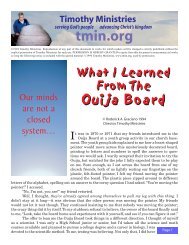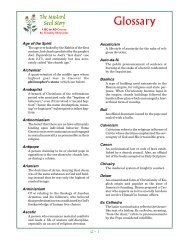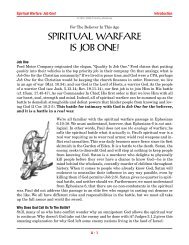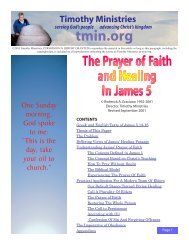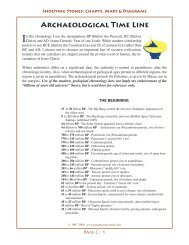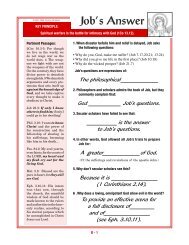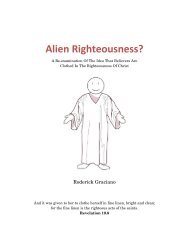Making The Invisible Visible Section 4
Making The Invisible Visible Section 4
Making The Invisible Visible Section 4
Create successful ePaper yourself
Turn your PDF publications into a flip-book with our unique Google optimized e-Paper software.
Hermeneutics: <strong>Making</strong> <strong>The</strong> <strong>Invisible</strong> <strong>Visible</strong> — © 2004 Roderick Graciano<br />
out relationally. This is exactly what Christ called the Rich Young Ruler to embrace.<br />
<strong>The</strong> Lord first pointed the young man to the commandments, which as we know can<br />
be summed up by “live in right relationship with God and with your neighbor.” <strong>The</strong><br />
young man claimed to have mastered this principle. So Jesus said to him, in effect,<br />
“Okay, if you understand the call to right relationship with God and man, then get rid<br />
of whatever would hinder you and come embark upon a personal relationship with me.”<br />
How do we inherit eternal life? <strong>The</strong> Scriptures are consistent: by entering a personal<br />
relationship with Jesus Christ.<br />
<strong>The</strong> Character Emphasis<br />
To Follow Christ (Luke 9.23; John 12.26; 13.15)<br />
To enter a personal relationship with Jesus Christ, as opposed to simply adopting a<br />
creedal assent to His claims, involves following Him. In our minds, following is something<br />
spatial and geographical, and it’s easy to read the statements of Jesus that way.<br />
Consider the one in John 12.26, for example: “Whoever serves me must follow me;<br />
and where I am, my servant also will be.” It sounds spatial and geographical, but the<br />
call to follow Jesus is relational, and the “place” where the servant of Jesus will “be”<br />
is not a geographical location but instead a character domain. It is the lifestyle landscape<br />
marked out by the priorities of Jesus. Yes, to live in that domain, may involve<br />
geographical travel, but it primarily involves character change. <strong>The</strong> “following” that<br />
we must do is the following of Christ’s example for living: “I have set you an example<br />
that you should do as I have done for you” (John 13.15).<br />
To Have A Good Eye (Mat. 6.22)<br />
Following Christ’s example helps transforms our character<br />
into His. Just as the Old Testament emphasizes<br />
character over outward appearance, the New Testament<br />
emphasizes character transformation over temporal comfort.<br />
We “rejoice in our sufferings, because we know that<br />
suffering produces perseverance, [and] perseverance [produces]<br />
character” (Rom. 5.3-4). “For those God foreknew<br />
he also predestined to be conformed to the likeness of his<br />
Son” (Rom. 8.29). That likeness involves all the fruit of<br />
the Spirit: “love, joy, peace, patience, kindness, goodness,<br />
faithfulness, gentleness and self-control” (Gal. 5.22,23), as<br />
well as other character qualities, including generosity.<br />
<strong>The</strong> call to generosity provides us with a Hebraism in Christ’s teaching that has<br />
puzzled translators. <strong>The</strong> Greek text of Matthew 6.22 reads:<br />
<strong>The</strong> lamp of the body is the eye, if then your eye may be single, your whole body shall be full of light.<br />
<strong>The</strong> King James version renders the key adjective correctly though strictly, as single.<br />
Later translators milked more meaning from the this Greek word single (aplous),<br />
recognizing that it means without folds, simple, sincere. Realizing that this unfolded<br />
simplicity must point in some way to the integrity of the eye, various versions have<br />
described the eye in this verse as “good” (NKJV), “clear” (NASB) and “healthy” (NRS).<br />
However, translators also puzzled over the oddity that Jesus only referred to one eye,<br />
Page 16


